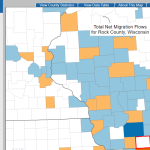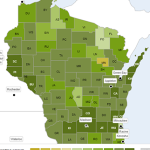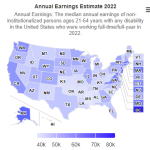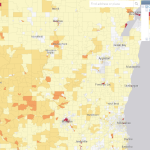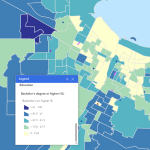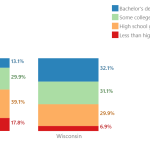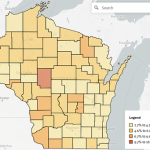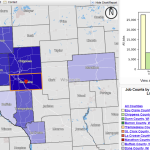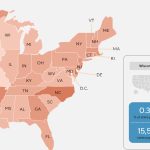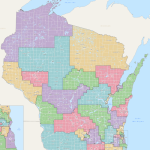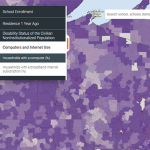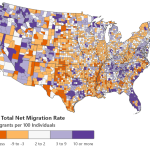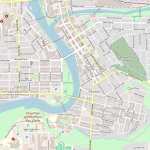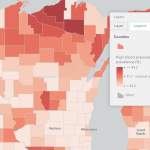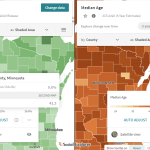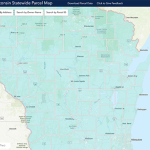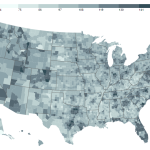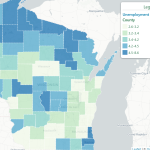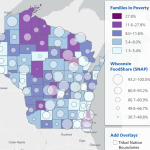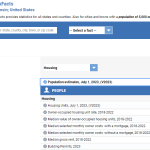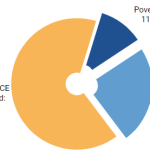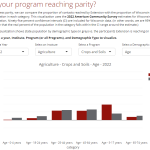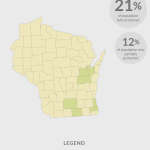The Census Flow Mapper is an interactive mapping tool that shows the estimated number of people who moved into or out of a given County, and where they moved to or from.
Census Reporter is a dashboard for visualizing Census data from the most current American Community Survey (ACS). Census geographies including State, County, and City can be selected using an interactive map.
County Business Patterns, from the U.S. Census, provides economic data by industry and number of employees. The County-level data includes the number of establishments by NAICS code, number of employees by sector, and annual payroll by sector.
This website presents rankings by County across the U.S. of various health related topics in two categories: health factors, and health outcomes.
The DHS Open Data Portal provides an extensive list of data related to health and behavior including: birth and death rates, life expectancy, illness, insurance, public health, lead, mental health, and substance use.
Disability Statistics is a state-level database designed to provide policy makers, advocates, journalists, and the public with access to demographic and socio-economic statistics on the non-institutionalized population of the U.S. with disabilities.
The Kids Count Data Center provides a convenient source of Department of Health Services, Department of Public Instruction, U.S. Census, and other data. Tables or maps for many socio-economic indicators that affect the lives of children and adults can be generated and downloaded.
Statewide visualizations and maps can be generated on this site to examine topics such as businesses, industries, the labor force, unemployment, wages, and several others.
EJScreen, the EPA’s Environmental Justice Screening and Mapping Tool is designed to highlight places that may have more exposure to health-impacting environmental risks and under-resourced or more vulnerable populations.
The EPD maps five categories of socioeconomic and demographic Census data at the County, County Subdivision, Tract, and Block Group levels, and includes a number of community assets for additional local context.
APL’s GetFacts is a tool for generating demographic profiles of Wisconsin Counties, County Subdivisions, or the State with a focus on population trends, health, housing, race and ethnicity, economics, or civil rights.
APL’s Hmong Chartbook is the most detailed information source available in regard to the Hmong/HMoob population of Wisconsin.
The Kids Count Data Center provides a convenient source of DHS, DPI, U.S. Census, and other data. Tables or maps for many socio-economic indicators that affect the lives of children and adults are available.
This resource is instrumental in understanding labor market dynamics. LEHD data consists of job mobility, commuting characteristics, and quarterly workforce indicator datasets.
Data Interactives is a resource developed by UCLA to provide information about LGBT people in the U.S.
The LTSB is the state’s authoritative source of legislative district information, and information about state representatives. Products available for download include district maps, election data, and redistricting data.
The ACS-ED interactive mapping tool allows the user to visualize socio-economic and demographic variables from the U.S. Census ACS by school district.
APL’s Net Migration Patterns is an interactive map showing the migration into and out of U.S. Counties disaggregated by age and race/ethnicity.
OpenStreetMap is a free and open geographic database of the built environment maintained and updated by a community of professionals and enthusiasts.
The Centers for Disease Control and Prevention’s PLACES data portal includes 36 chronic disease measures that can be used to develop targeted prevention activities and identify health problems.
PolicyMap makes one of the most extensive lists of demographic and socio-economic variables accessible in one place—at nearly every level of geography imaginable. Current Census data exists alongside historical data of various types.
The Social Explorer, available with a UW NetID login, allows the user to access and map an extensive list of demographic, socio-economic, health, environmental, business, and election data sets.
This resource aggregates local parcel datasets into a statewide file. The data includes typical attributes such as owner name, address, school district, assessed values, and property tax.
StatsAmerica is an extensive and up-to-date collection of data and indices related to economic and community development. The site is also a handy source of Census and other federal data at the County, Place, or MSA level.
APL’s Wisconsin Food Security Project provides data to help identify food security strengths, risk factors, and gaps via socio-economic factors.
APL’s Wisconsin Risk and Reach Project assesses potential gaps between publicly funded programs and community risks especially as they relate to children and families.
The U.S. Census’ QuickFacts site provides a customizable table of common demographic and socio-economic statistics for the U.S., individual States and Counties, or cities and towns with populations of more than 5,000 people.
The United Way developed the ALICE (Asset Limited, Income Constrained, Employed) metric to examine the group of households earning more than the Federal Poverty Level, but not enough to afford the essentials for survival in the communities in which they reside.
The USDA conducts a census of U.S. farms and ranches at five year intervals looking at “land use and ownership, operator characteristics, production practices, income, and expenditures.”
The Parity Visualizer allows users to observe the extent to which UW Extension programing is reaching the population of Wisconsin by comparing the demographics of participants with those of the state.
This site contains statistics related to Wisconsin’s L.G.B.T.Q. population including information about relevant policy.
